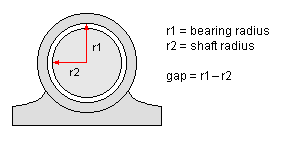Having looked at a little theory, let's return to the traditional view that conformance to specifications is sufficient. In the appendix to Economic Control, Shewhart refers to a simple assembly, that of a shaft and bearing. For the assembly to function properly, there must be some clearance between the two components. However, if the gap is too great, the assembly will be too loose to be functional. Therefore, the specification for the assembly must be such that the gap in any random pairing of a shaft and a bearing will be greater than zero and less than the desired maximum.  In the following pages, we shall be looking at an example case in which:
We know that the processes for making the shafts and bearings will be subject to some variation, so we specify the shaft with a radius of 10.0mm ±0.10mm. In order to achieve the requisite clearance, we specify the bearing with a radius of 10.05mm, also ±0.10mm. Let's assume that each process is centred directly on the target value, and has a standard deviation of 0.03. Remember from The Voice of the Process that almost all the data in a normal distribution will be contained within 3 standard deviations of the mean. This means that:
 |